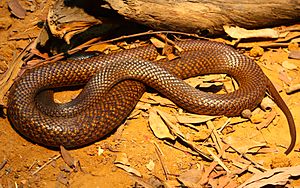Northern brown snake facts for kids
Quick facts for kids Pseudonaja nuchalis |
|
|---|---|
 |
|
| A northern brown snake at the Australia Zoo | |
| Conservation status | |
| Scientific classification | |
| Genus: |
Pseudonaja
|
| Species: |
nuchalis
|
The northern brown snake (Pseudonaja nuchalis) is a very fast and highly venomous snake found in Australia. It is also known by its Aboriginal name, gwardar. This name means "go the long way around," which is good advice if you ever see one!
Northern brown snakes are usually shy and prefer to move away from people. However, they will defend themselves if they feel trapped or threatened. Their color and patterns can change a lot depending on where they live.
Contents
What Does the Northern Brown Snake Look Like?
Northern brown snakes can grow up to about 1.8 meters (nearly 6 feet) long. Their backs can be orange-brown with spots or stripes, or they might be plain. Their bellies are usually cream or orange with pink blotches.
Some northern brown snakes have completely black heads. This can make them look a bit like the Black-headed python. Others might have a black 'V' shape on the back of their neck.
Where Do Northern Brown Snakes Live?
These snakes are found across the northern parts of Australia. This includes the Northern Territory, Queensland, and Western Australia.
The northern brown snake lives on the ground. It likes dry places, but you can also find it in eucalypt forests, woodlands, and grasslands near the coast. Even though they are ground snakes, they sometimes climb small shrubs or trees. They also like to hide in cracks, under rocks, or even under piles of rubbish in towns.
What Do Northern Brown Snakes Eat?
Northern brown snakes are predators. They hunt and eat small mammals and other reptiles. Their favorite meals include lizards and mice. They kill their prey using both their venom and by constriction (squeezing them).
Northern Brown Snake Life Cycle and Reproduction
Scientists don't know much about how long northern brown snakes live. Their mating season is usually from September to November. A female snake typically lays about 11 to 14 eggs. However, some females can lay as many as 38 eggs!
Understanding Northern Brown Snake Venom
Even though the northern brown snake's venom is not the strongest among all brown snakes, it delivers a lot of venom in one bite. This means its bite can be very dangerous.
The venom contains different types of toxins:
- Neurotoxins: These affect the nervous system, but usually don't cause problems for humans.
- Nephrotoxins: These can harm the kidneys.
- Procoagulants: These affect blood clotting.
A bite from a northern brown snake is often painless and hard to see because their fangs are small. If a human is bitten, symptoms can include a headache, feeling sick (nausea and vomiting), stomach pain, and serious blood clotting issues. Sometimes, it can also cause kidney damage. For pets like dogs and cats, paralysis is also a common symptom.
Northern Brown Snake Behavior
Northern brown snakes are known to be very aggressive if they are bothered or feel threatened. But like most snakes, they usually prefer to get away from danger.
During warmer months, they might become active at night. Otherwise, they are usually active during the day and enjoy being in the sunlight. These snakes have also been known to eat other snakes (this is called cannibalism), but it's not very common.
- Boulenger GA (1896). Catalogue of the Snakes in the British Museum (Natural History). Volume III., Containing the Colubridæ (Opisthoglyphæ and Proteroglyphæ), ... London: Trustees of the British Museum (Natural History). (Taylor and Francis, printers). xiv + 727 pp. + Plates I-XXV. (Diemenia nuchalis, pp. 326–327).
- Günther A (1858). Catalogue of the Colubrine Snakes in the Collection of the British Museum. London: Trustees of the British Museum. (Taylor and Francis, printers). xvi+ 281 pp. (Pseudonaja nuchalis, new species, pp. 227–228).
See also
 In Spanish: Serpiente marrón del norte para niños
In Spanish: Serpiente marrón del norte para niños


